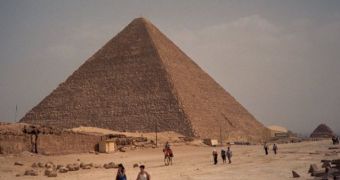1. The fertile banks of the Nile River offered several annual crops, as many floodings the river produced. The farmers would eagerly wait for the flooding, because after the water's retreat, the fields remained covered with a thick layer of mud on which the crops grew rapidly. This condition boosted the existence of various independent agricultural settlements. But around 5,200 BC, the first pharaoh, Menes, unified by war all the populations inhabiting the lower valley of the Nile River. Menes founded the first Egyptian dynasty and, like all the succeeding pharaohs, he was considered a god.
2. The kings of the first Egyptian empire, called the Ancient Empire, built gigantic pyramid-shaped tombs. In its interior, the construction had a chamber where the mummified cadaver of the pharaoh was deposited, with a plethora of offerings: food, clothes, jewels, dishes, and other. To avoid the theft of these treasures and tomb's profanation, inside the pyramid the architects built a real labyrinth of false passages to confuse the thieves. It was calculated that for building the pyramid of Kheops, the largest ever, 110,000 workers labored for 25 years. It is the only one of the Seven Wonders of the Ancient World still standing, 138.8 m (455.2 ft) tall.
3. Accommodated Egyptian families lived in beautiful mansions built of adobe or stone, close to canals or the Nile itself. Each dwelling had one level and an inner courtyard with a pool with papyrus and lotus. Against the hot climate, the houses had small external openings, just some very small windows which, with the serene sky of Sahara, delivered enough light for the houses during the day. The entrance to the house had porches sustained by columns, reunion places for men at the sunset. But if the tombs were richly decorated with wall paintings and bas-reliefs, the houses were not.
4. The tombs were the place were Egyptian art (painting, sculpture and jewelry) reached its highest. Tombs varied along the time. The first type were pyramids and mastabas (small buildings made of mud brick, rectangular in plan with sloping sides and a flat roof, leading to a well carved in the ground leading to the funerary chamber), then speos (rock cut chapels in rocky cliffs).The tombs were richly adorned with art works: sculptures in painted wood, stone or ceramic dishes, coffins with the dead person's effigy, wall paintings in vivid colors and stone reliefs. Still, Egyptian art varied very little along the centuries.
5.The main Egyptian god was Amon Re, the king of all gods. The god Ra Harakti was represented with human body and falcon head. His daughter was Maat, the goddess of truth and justice. One important Egyptian symbol was that of the solar disk surrounded by the sacred snake. Crocodiles were sacred in the ancient Egypt, and they were even embalmed; large embalmed crocodiles were found in many tombs and sacred edifices. A sacred bird was the ibis.
Egyptians used to embalm baboons, cats, dogs, falcons, mice (representing the hearts of the sinners, offered to Osiris, the god of death). Human mummies show that Egyptians used prostheses 3,000 years ago.
6.Ancient Egyptians were physically very similar to the modern Egyptian peasants, called fellahs. Nobles, priests, and the pharaohs shaved their heads and wore various types of caps and wigs. Oppositely, villagers or artisans wore long hair and shaved their beards. Against the hot sun, Egyptians wore linen clothes. In time, linen use turned exclusive for some social classes and served as cast distinction.
The Egyptian attire consisted generally from a short fabric skirt and a tunic reaching to the ankles. The costume was completed with various adornments. Egyptian women were famous for their make up: they used khol, a black dye for outlining the eyes, ocher powder to give a healthy color to the cheeks, and a vegetal red liquid, called hena, for smearing their hands. Their toiletries included very refined tools: depilating pincers, palettes for mixing the beauty products and ivory sticks for applying them over the skin. They used wigs too, adhered to the head with gold and gemstone diadems and from which bead strings and fine metal plates hung. Noble women possessed luxury jewelry, like wide pearl collars, lapis lazuli, or glass beads.
7. The Egyptians were feared for their war chariots. The Egyptian war chariot was driven by two horses and provided a very rapid deadly advance. The horse and chariot were introduced into Egypt during the 17th century BC during the invasion of the Hyksos, a Semitic tribe coming from Syria and Palestine.
Along their history, Egyptians made long conquest or punishment expeditions into Palestine, Phoenicia, Minor Asia, and Black Africa (like Nubia), this way maintaining the border of the empire. Egyptian archers were very skilled also. Chariots were used by the pharaohs for hunting as well, like in the lion hunt. The hunt of the lion was reserved to pharaohs and nobles (today, lion is extinct in Egypt).
8. The Nile was the main communication route in Egypt. Egyptian ships had a large rectangular or square sail and, despite their size, they were of low draft, which allowed them to avoid sandbanks, and were controlled through rudders of large reed astern. In that place, the highest part of the ship, an awning, was raised for storing the transported goods and make shelter during the voyage. Fishing boats were made like bundles of entwined woody vines and their curved stern somehow resembled a lotus flower. They were driven with poles, and fish were usually harpooned in shallow waters.
9. Egypt was an agricultural state; all classes were involved in it. The pharaohs made norms and laws, nobles surveyed the field work, while the slaves made the seeding and harvesting. The Egyptians turned desert patches into croplands, irrigating them with the Nile's water. This was realized through a complicated network of irrigation ditches and canals.

 14 DAY TRIAL //
14 DAY TRIAL //